One of the most common questions that rug buyers often get asked is, “How can you tell the difference between a handmade rug and a machine made rug?“
Growing up in the rug business, I’ve always been amazed by the skill of rug experts like my father. The ability to instantly identify a rug’s origin, age, and craftsmanship, whether it’s a traditional hand-knotted piece or a machine made Persian rug, feels like a superpower.
In this post, I’ll share simple tactics to help you distinguish between machine-made rugs and hand-knotted rugs. Whether you’re a homeowner fascinated by machine made rugs or a business owner in the rug industry, these tips will be invaluable.
We’ll cover aspects like rug appearance, knot quality, and fringe inspection. Read on to acquire your rug identification superpower and learn how to spot the unique qualities of machine made Persian rugs.
Table of Contents
Can Persian Rugs be Machine-made?
Persian rugs, traditionally known for their intricate hand-knotted craftsmanship, can indeed be machine-made in contemporary times. The machine-made versions aim to replicate the aesthetic of traditional Persian rugs using modern manufacturing techniques.
These rugs are often produced more quickly and at a lower cost compared to their hand-knotted counterparts, and they are typically made from synthetic materials like polypropylene, nylon, or polyester.
While they lack the unique artisanal qualities of hand-knotted rugs, machine-made Persian rugs offer an affordable and practical alternative for those seeking the Persian rug aesthetic.
How Long Do Machine-made Rugs Last?
Handmade rugs typically last significantly longer than machine-made rugs due to their superior craftsmanship and materials. A well-maintained handmade rug can last anywhere from 20 years to over a century. Factors like material quality, knot density, and care significantly influence their longevity.
In contrast, machine-made rugs generally last between 5 to 20 years, depending on the quality of the synthetic materials and construction. Their lifespan is influenced by the level of foot traffic and maintenance. While handmade rugs are often considered valuable heirlooms, machine-made rugs are more for practical, short-term use.
A Closer Look: Handmade VS Machine-made Persian Rugs
While it may not be easy to distinguish between the two with just a casual glance, especially to an untrained eye, a closer look will reveal a few very prominent differences between the two.
Machines-Made Rug Appearance
Machine-made rugs, including popular machine made Persian rugs, are known for their perfect, symmetrical designs and patterns.
The spacing of the medallions, motifs and other design elements are consistent throughout the rug, and the overall look and feel of the rug can be fuzzy and less sharp.
This is due to the lower knot density and the limitations of the machine in handling the nuances of the patterns and colors compared to an expert weaver.

Hand-Knotted Rug Appearance
Conversely, hand-knotted rugs are characterized by their harmonious but not always perfectly symmetrical designs and patterns. The level of symmetry will vary depending on whether the rug was made in a workshop or by tribal or village weavers.
City rug weavers who work in workshops typically follow a blueprint, and their designs are the most experienced and closest to perfect.
Tribal or village rug weavers, on the other hand, do not follow a blueprint and instead rely on their memory, resulting in more apparent imperfections in the designs.
However, even the most experienced weavers can make small mistakes. These mistakes can result from changing the pressure to tie knots or beat down on the pile as they weave. While these small mistakes may be noticeable to a trained eye, they can be difficult for an untrained eye to detect.
By understanding these differences in the appearance of machine-made rugs and hand-knotted rugs, you can develop your eye for identifying the construction of a rug.
Inspecting the Straightness of a Rug
One of the biggest giveaways to know whether a rug is machine-made or hand-knotted is to inspect the rug for straightness.
How to Measure Straightness
To check the straightness of a rug, start by looking at the four edges of the rug. A trained eye can tell with a glance how straight a rug is, but for more precise measurement, use a tape measure to measure the distance from each corner of the rug. For example, measure the distance from the top left and top right corners, and do the same for the bottom left and bottom right corners. Compare the measurements to see how much difference there is.
Machine-made Rugs: Perfectly Straight with Little Difference
Machine-made rugs are known for their perfectly straight edges with almost no difference in measurement. These rugs are produced using advanced machinery that ensures precise measurements and even weaving.
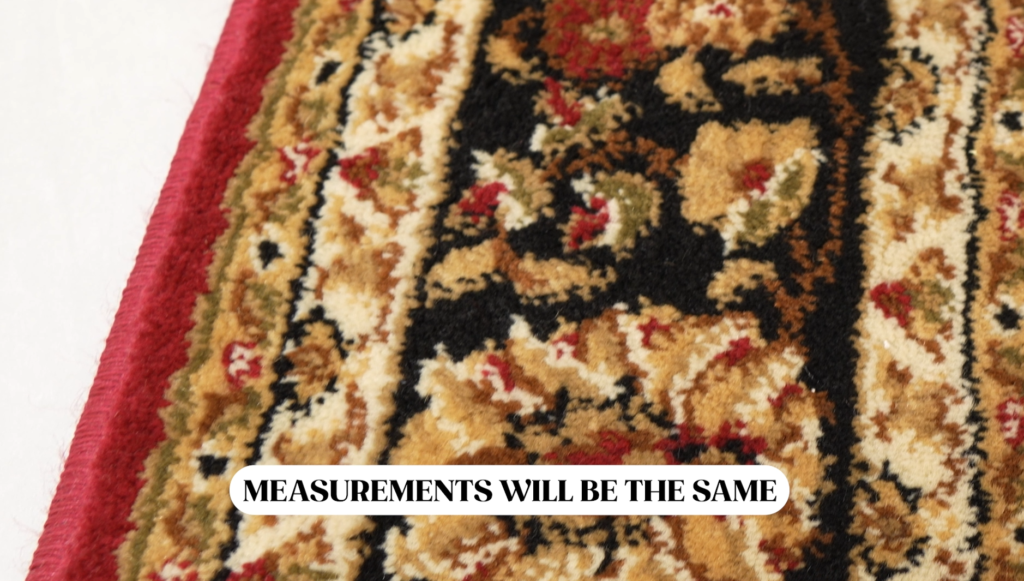
Hand-knotted Rugs: Slight Differences in Straightness Are Normal
On the other hand, hand-knotted rugs may have slight differences in straightness, especially those made by tribal or village weavers. A couple of inches of difference is normal, but depending on the size of the rug, it shouldn’t be much more than 3 or 4 inches.
The Role of Looms and Knot Tightness in Rug Straightness
The straightness of a hand-knotted rug is determined by several factors, including the loom used to make the rug. Wooden looms are known for expanding and contracting, which can impact the straightness of the rug. Additionally, the tightness of the knots in different areas of the rug can also impact its straightness. Also, wool foundations are known for expanding and shrinking over time which can lead to distortions in the rug.
Feeling the Back of a Rug
When it comes to identifying the authenticity of Persian rugs, one method is to check the back of the rug. By feeling the back, you can determine whether a rug is machine-made or hand-knotted by feeling the back.
Machine-made Rugs: Hard and Stiff Backs Indicate Synthetic Material
Machine-made rugs, such as machine made Persian rugs, will have hard and stiff backs, indicating synthetic material. The back of these rugs is often synthetic, such as polypropylene, nylon, or polyester.
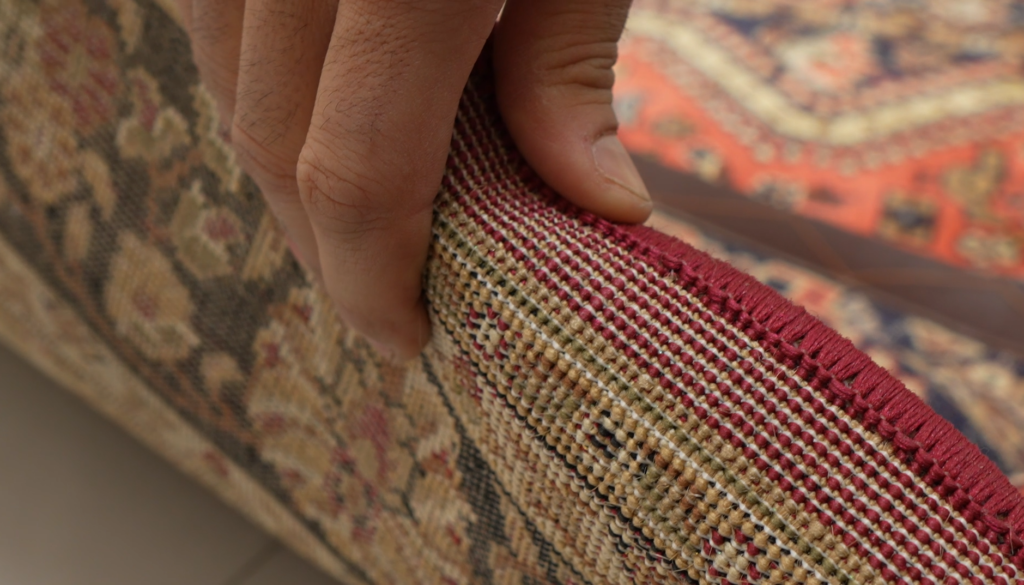
Hand-knotted Rugs: Soft Backs with Natural Materials
On the other hand, the back of a hand-knotted rug feels relatively soft when you run your fingernails along it. This is because you feel the natural materials used in the rug’s foundation and pile. Hand-knotted rugs are made of natural fibers such as cotton, wool, or sometimes silk and are woven together by skilled weavers using traditional techniques.
Identifying the Foundation of Hand-knotted Rugs by Feeling the Back
Feeling the back of a hand-knotted rug can also reveal the quality of its foundation, which consists of the warp and weft threads onto which the knots are tied. The back can assess by feeling the softness of the natural fibers used, such as cotton, wool, or silk, and the precision of the weaving. Thus, feeling the back of the rug can provide valuable information about its authenticity and quality.
Checking the Knots on the Back of a Rug
Another way to tell the difference between machine-made and hand-knotted rugs is by inspecting the knots on the back of the rug. By looking closely at the back of the rug and inspecting the knots, you can identify whether a rug is machine-made or hand-knotted.
If the weaving and the knots are not perfectly uniform, you know it is a handmade rug. In addition, you can actually distinguish the individual knots when you look at the back of the rug.
This is because, in making handmade rugs, weavers manually insert the knots into the foundation of the rug and tie each knot by hand. Not surprisingly, because it is a fully manual process, this results in the unevenness that you can see on the underside of the rug.
Machine made rugs, on the other hand, are manufactured by large, heavy-duty power looms and because the process is entirely automated the resultant rug will have a smooth and even underside. In a machine made rug, the back of the rug will typically be very uniform and perfectly even.
You cannot see individual knots at the back of a machine made rug because there aren’t any. The pile is held together by an overstitch construction and this smooth over stitch pattern is what you can see on the entire back of a machine made rug.
Machine-made Rugs: Uniform Knots with Perfect Symmetry
Since machine-made rugs are produced by machines, the knots on the back of the rug will appear uniform and very symmetrical. The spacing between the knots and the overall structure will look perfectly aligned, almost like a perfect honeycomb structure. The rug pile is not visible from the back, and the design and colors are unclear.
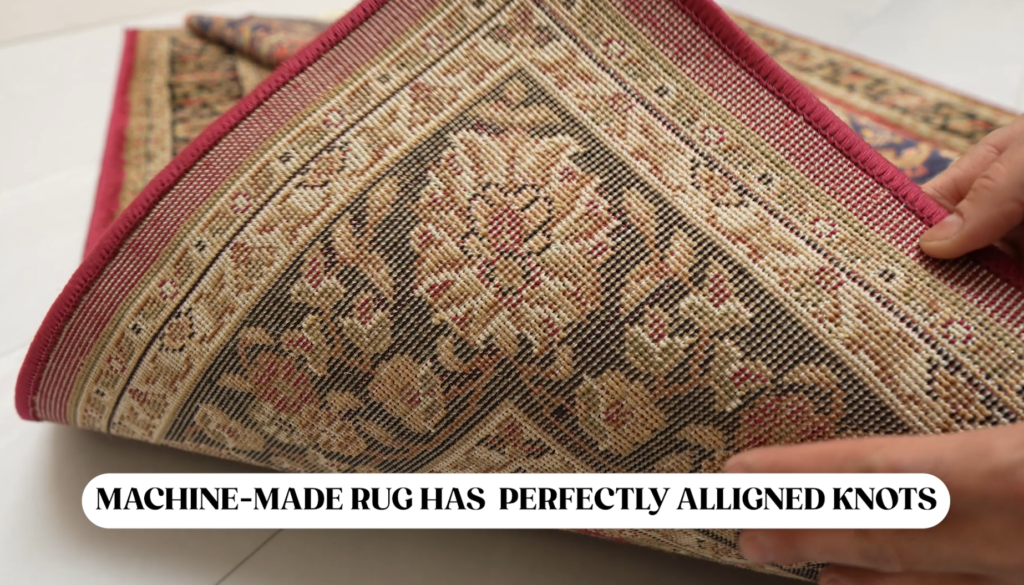
Hand-knotted Rugs: Uniqueness in Knots with Clearer Patterns
Conversely, the knots on the back of a hand-knotted rug will not look perfectly symmetrical and aligned since they are knotted by hand. Instead, you’ll notice more uniqueness in the rug patterns instead of a honeycomb structure. You can see the rug pile clearly as if it’s been cut very short. This means you can easily determine what the rug will look like in the front, including the design and colors.
Visible Pile on Hand-knotted Rugs
By checking the knots on the back of a hand-knotted rug, you can identify the design and colors of the rug. The visible pile on the back of the rug can give you a clear idea of what the rug will look like in the front. The knots in different areas of the rug may also vary in size and shape, which is a sign of the rug’s authenticity and the skill of the weaver. When inspecting the back of a rug, pay attention to these details to differentiate between machine-made and hand-knotted rugs.
Checking the Fringes of Wool Rugs
Another way to differentiate between machine-made and hand-knotted rugs is by examining the fringes. In machine made rugs, synthetic fringes with a uniform appearance are common, while hand-knotted rugs have natural material fringes with unique characteristics.
Fringes are the strands that hang off the ends of a rug, and they can provide valuable information about the rug’s construction.
In authentic Persian rugs, the fringe is part of the body of the rug itself. It is formed during the weaving process and looks like an extension of the rug body.
Machine-made Rugs: Synthetic Fringes with Uniform Appearance
Sometimes, machine-made rugs do not have any fringes. If they have fringes, they are usually attached to the rug after it’s made, and they’re made of synthetic materials such as nylon, polyester, or polypropylene. It is in fact rather sewn onto the rug after the rug-making is completed. The fringes on machine-made rugs have a simple and uniform appearance.
Take a closer look at the part where the fringe is attached to the body of the rug. If you can see that is has been sewn to the rug then you know the rug is NOT genuine.
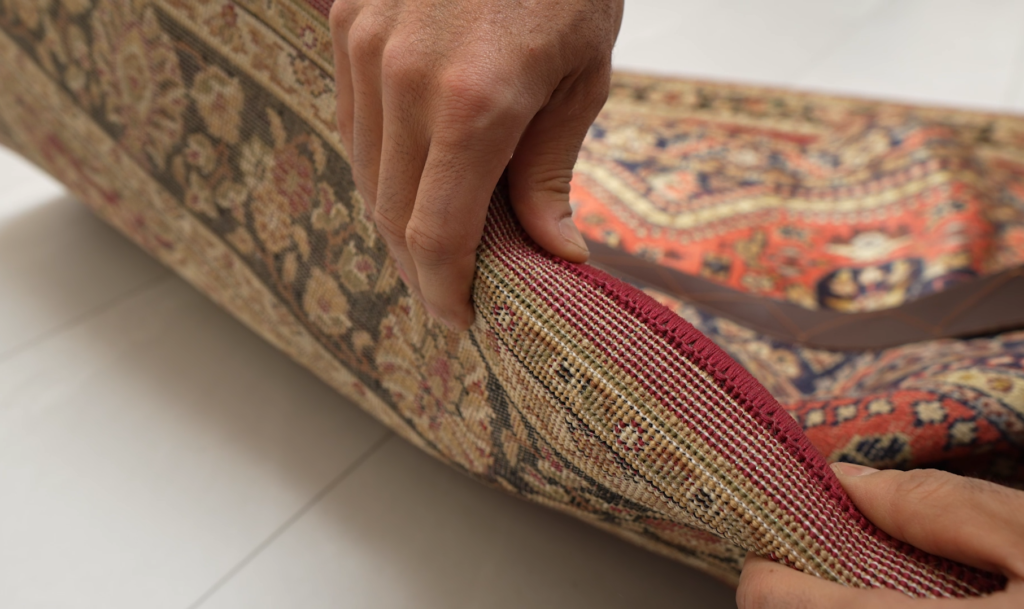
Hand-knotted Rugs: Natural Material Fringes with Unique Characteristics
In contrast, the fringes on a hand-knotted rug are part of the rug’s foundation, and if you look closely, you can see how they are an extension of the foundation. They are usually made of natural materials such as cotton, wool, or sometimes silk. Hand-knotted fringes are less uniform than those on machine-made rugs and can vary in length or thickness. Sometimes, they are braided or decorated, especially in tribal or village rugs, which add character and unique features to the rug.
Fringe Variations in Tribal or Village Hand-knotted Rugs
Tribal or village weavers may also intentionally create variations in the fringes to add character to their rugs. For example, they may make the fringes on one end of the rug shorter than the fringes on the other end, or they may add decorative touches to the fringes, such as tassels or knots. By examining the fringes of a rug, you can identify its construction and get a sense of its unique features and characteristics.
Look for Color Variations
Handmade rugs are more likely to have slight variations in color. This is because the process is entirely manual including the dyeing process.
Using the finest wool that has been dyed in different batches will often result in slight color variations. With machine-made rugs, the materials used are typically dyed in a single batch and the colors will be uniform throughout.
In conclusion, identifying the construction of a rug can seem daunting, but with these simple tactics, you can quickly tell the difference between machine-made and hand-knotted rugs. By inspecting the vibrant colors, knot quality, fringes, and straightness, you can develop your own eye for rug identification.
Remember, machine-made rugs have a perfect appearance, uniform knots, and synthetic fringes. In contrast, hand-knotted rugs have unique patterns and imperfections, natural materials in the knots and fringes, and slight differences in straightness.
What are the Benefits of Machine-made Persian Rugs?
Budget-Friendly:
Cost-Effective: One of the most significant benefits of machine-made rugs is their affordability. Compared to hand-knotted rugs, they are far less expensive, making them accessible to a wider range of budgets. This affordability allows for more frequent updates to home decor without a substantial financial investment.
Durability:
Resilient Materials: Machine-made rugs are often crafted from synthetic materials like polypropylene, nylon, or polyester, which are known for their durability. These materials are resistant to wear and tear, making machine-made rugs a long-lasting addition to high-traffic areas.
Consistent Quality: The manufacturing process ensures consistent quality across all rugs, providing uniformity in durability and appearance.
Wide Variety of Designs:
Diverse Styles and Patterns: Thanks to modern manufacturing technologies, machine-made rugs are available in an extensive range of designs, colors, and patterns. This variety ensures that there is a rug to suit every interior design style, from traditional to contemporary.
Replicating Expensive Designs: Machine-made rugs can replicate the look of more expensive, handcrafted rugs, making luxurious designs more accessible.
Easy to Maintain:
Simple Cleaning Process: The synthetic fibers used in machine-made rugs are generally easier to clean than those in handmade rugs. Many are stain-resistant and can be cleaned with regular vacuuming and occasional spot cleaning.
Ideal for Allergy Sufferers: Unlike some hand-knotted rugs that may shed fibers, machine-made rugs typically do not, making them a better option for people with allergies.
Hypoallergenic Properties:
Reduced Allergens: The materials used in machine-made rugs are often less likely to trap allergens, which is beneficial for allergy sufferers. The ease of cleaning also means allergens can be regularly removed from the rug’s surface.
Quick Production Time:
Efficient Manufacturing: Machine-made rugs are produced much more quickly than hand-knotted rugs. This rapid production time means they can respond swiftly to trends and customer demands.
Availability: The quick production cycle ensures a steady availability of a wide range of designs and sizes, making it easier for consumers to find the perfect rug for their space.
Versatility:
Suitable for Various Settings: From residential to commercial spaces, machine-made rugs can adapt to different environments due to their durability and variety in design.
Ease of Replacement: Given their affordability, these rugs can be replaced or switched out with ease, allowing for frequent decor changes.
In summary, machine-made rugs offer a practical and cost-effective solution for those looking to enhance their living spaces. Their durability, variety in design, ease of maintenance, hypoallergenic properties, and quick production time make them a popular choice in modern interior design.
However, if you’re looking for an authentic hand-knotted rug, or want to explore a variety collection of machine made Persian rugs, check out our inventory of over 3,000 rugs to find the perfect one.

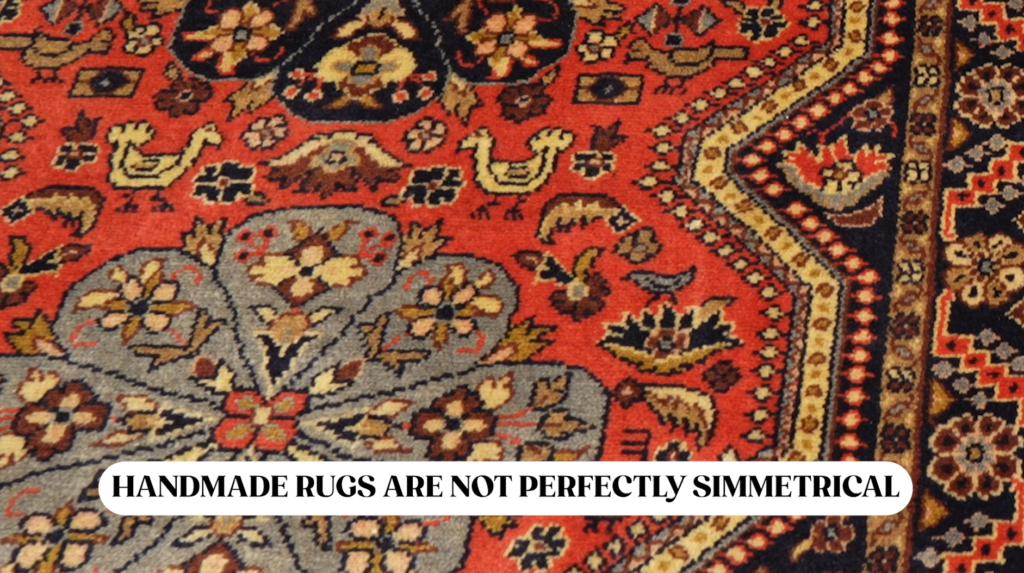
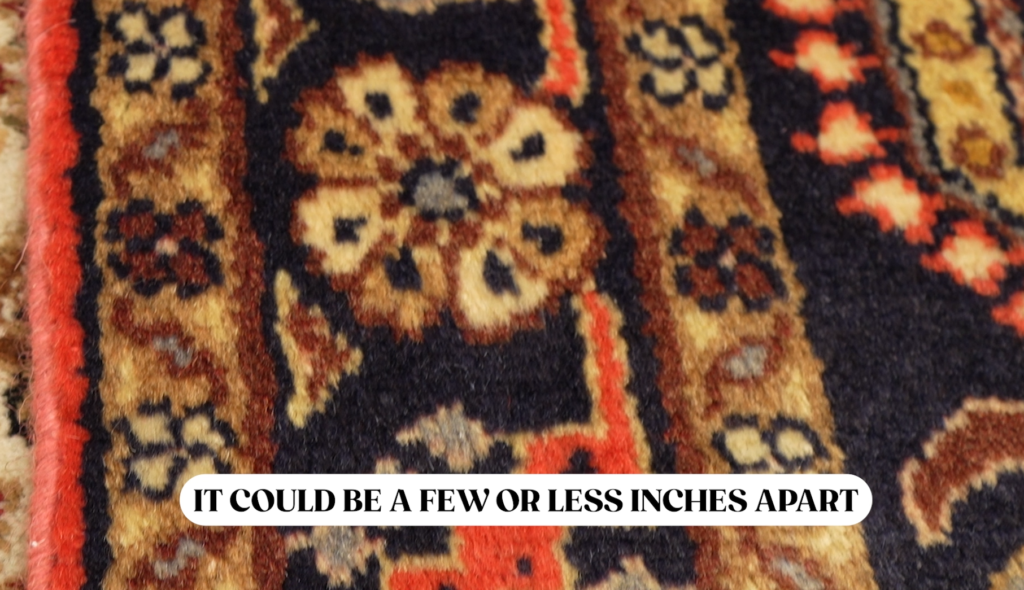
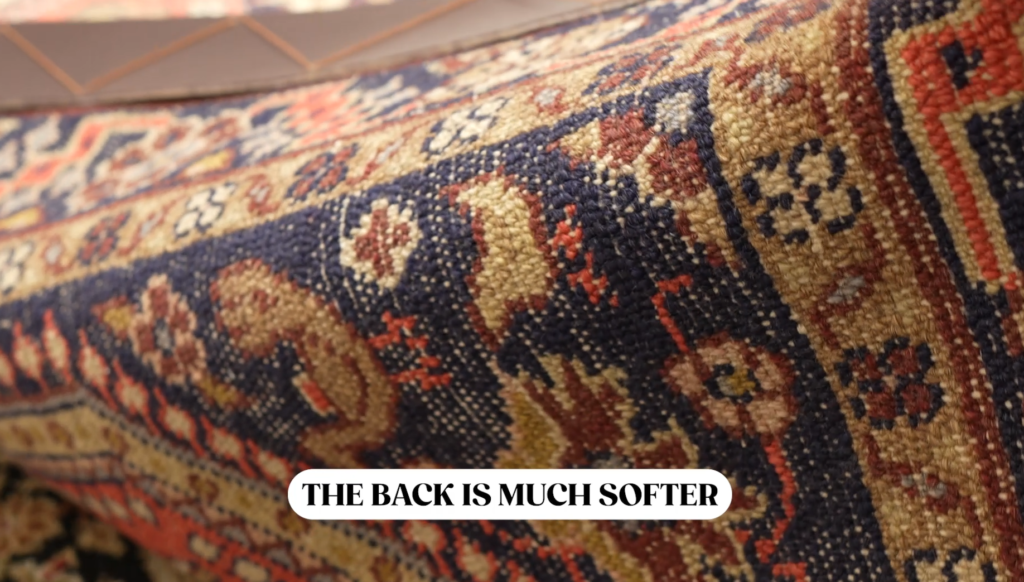
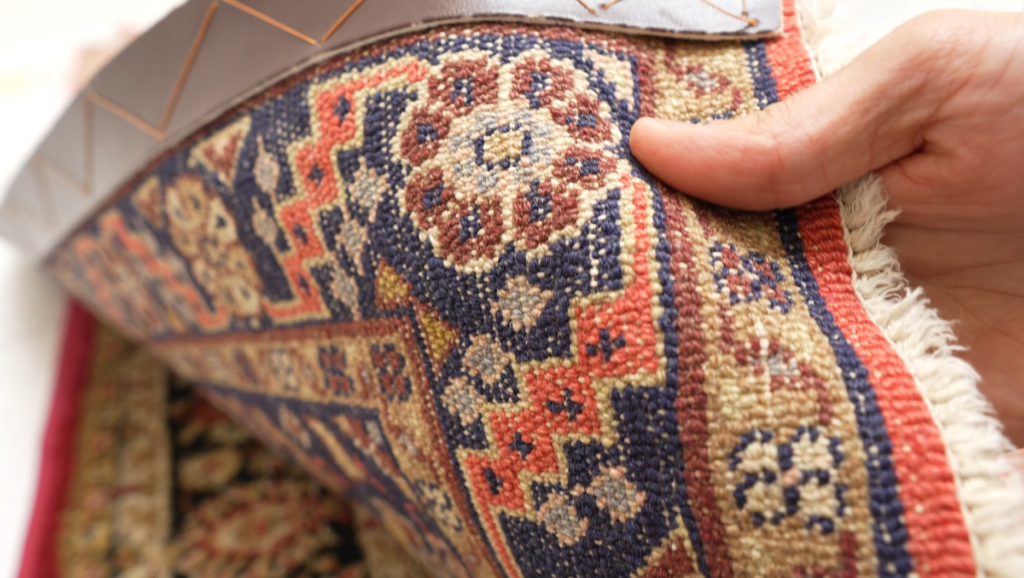

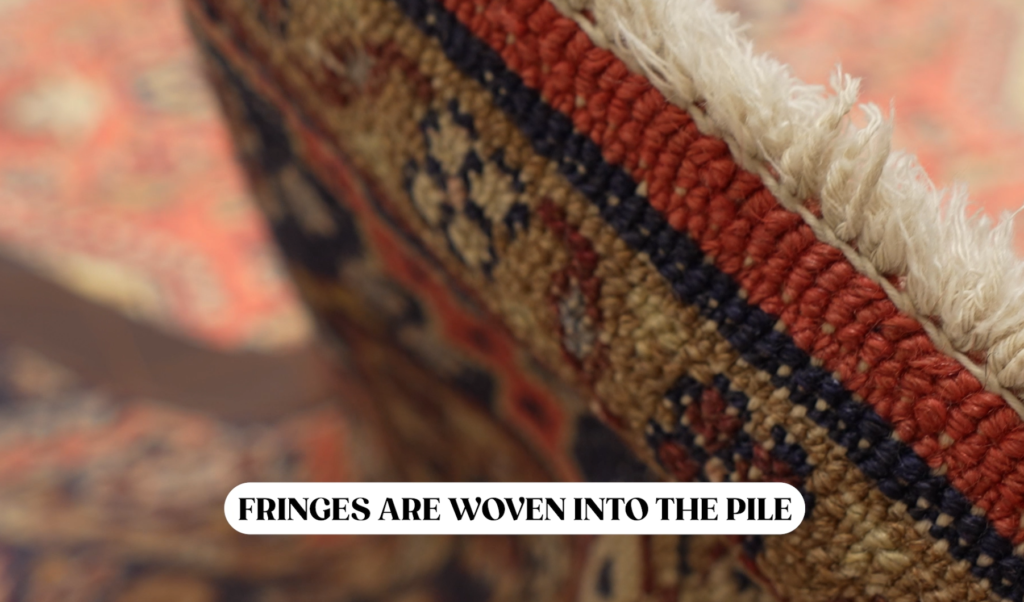
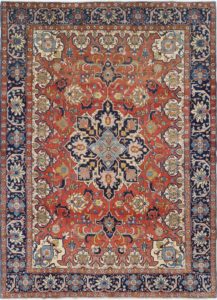
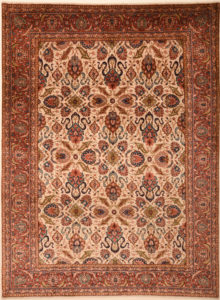
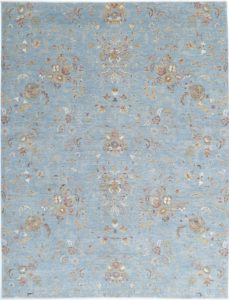
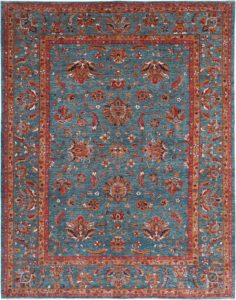
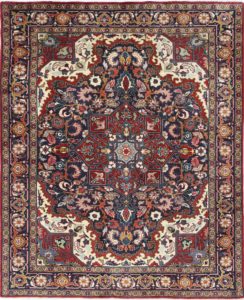
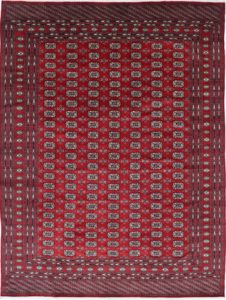
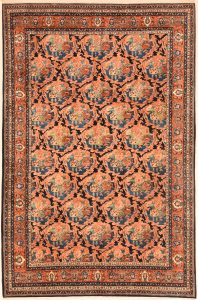


2 thoughts on “How To Tell The Difference Of Handmade Vs Machine Made Rugs”
If I send you of a beautiful rug that o am curious about (I’m a weaver and am simply baffled) would you be willing to tell me how it was made?
I think machine but NO loose ends anywhere in the multiple pattern changes.
Could be made on a tapestry loom but way too perfect.
A binding was hand sewn all along the bottom edges.
Yes of course, you can send the pictures to info@catalinarug.com with your request. We’ll take a look and see if we can identify it for you.